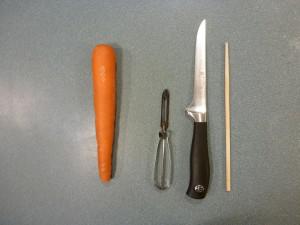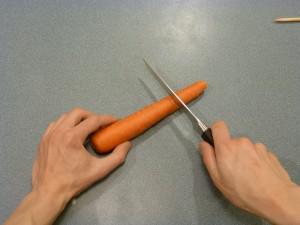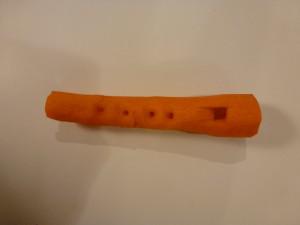This is another great guest post by Niko Johnstone, a writer and recording engineer from Portland, Maine. You can contact Niko at [email protected].
How to Make a Carrot Recorder
Sometimes it is okay to play with your food. In fact, with a little bit of ingenuity, your vegetable bin can become an amazing toy box. If you’ve ever carved a pumpkin, you can make a carrot recorder. This simple guide will show you how.

- 1 Large Carrot – An ideal carrot will have no visible cracks and will be at least one inch in diameter. The best place to find carrots of a larger size is at an organic supermarket.
- A ¾ inch, and ¼ inch drill bit, or a vegetable peeler
- Chisel or knife
Step One – Hollowing Out Your Carrot
The first thing you’ll want to do after selecting your carrot is cut it to the proper length. There isn’t a set length your carrot must be, but the end of most carrots will be too thin to carve. Make sure you save the end, after cutting it off, we’ll be using it later on. The easiest way to hollow out your carrot is by using a drill. Carrots are soft enough that you can do this by hand, without the use of a power drill. If you don’t have access to a drill bit, a long, curved vegetable peeler should do the trick.

The sound a flute makes is produced when air is forced against an edge of some sort, splitting the airflow. On a recorder, this edge is called a lip, and the rectangular opening just before the lip, the aperture. To make the aperture, cut out a rectangular piece of carrot, ¾ of an inch from the big end. The aperture will need to be ¾ of an inch wide, and ½ of an inch in length. To thin the lip, hold your chisel at a 20 – 30 degree angle, and start cutting ½ of an inch from the edge of the lip. For those using a knife, the slope will be more difficult to cut, but not impossible. Begin cutting at the edge of the lip first, and work your way back ¾ of an inch. It’s a good idea to start with a wider angle, and cut away more carrot, as needed.
Step 3 – Making the Mouthpiece
This is where the carrot piece that you saved will come in handy. Make sure it is about ¾ of an inch in diameter and length. If it’s too thin, you can use a baby carrot, or cork. Cut off 1/16 of an inch of the circular part of the piece, making sure that the cut is perfectly smooth. Now, insert the carrot piece into the large end of the carrot, lining up the opening you’ve made, with the aperture.

Use your ¼ inch drill bit, to make holes along the length of the recorder. Alternately, a sharpened chopstick, or other skewer will work well for this task.
Troubleshooting
If your recorder isn’t making a sound, the problem is most likely a result of two things: an air leak in the mouth piece, or an improperly shaped aperture and/or lip. If the sound is too soft, try re-cutting the piece inserted into the end, so that it is 1/8 of an inch at its opening, and half that size where it meets the aperture. If the carrot cracks, there’s little you can do, but duct tape works wonders.
Now that your carrot recorder is complete, you can enjoy a true feast of music. Just make sure to keep to your instrument nice and cool, so it will last as long as possible.
